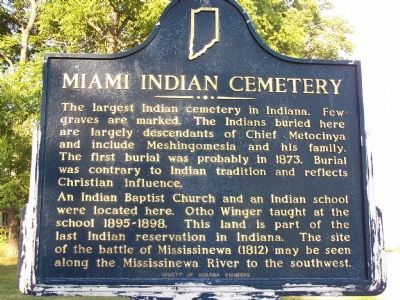 Rev. Isaac McCoy (1784-1846) was a Baptist minister, Indian missionary, surveyor, and author.
Rev. Isaac McCoy (1784-1846) was a Baptist minister, Indian missionary, surveyor, and author.
“In 1810 McCoy was ordained a Baptist minister and seven years later was sent by the Baptist Board of Foreign Missions in America to the Miami Indians, who were living on the Wabash river, 16 miles above Terre Haute, Indiana. This was his first missionary experience but he was to spend the remainder of his life in this and related fields.” In subsequent years, McCoy worked among various tribes in Indiana, Kansas and surrounding areas. In the 1830s McCoy was routinely “employed by the government in the Indian country, selecting and surveying locations for the immigrant Indians and establishing and maintaining missions and schools.”
In 1829 the Rev. McCoy was sent by the Baptist Foreign Missionary Society to Fort Wayne, about the time that the Union Baptist Church of Grant County was formed as an Indian church.
Today, the Union Church is reorganized – that is, re-started after a time of inactivity. According to Indiana Baptist records:
Consistent members of a regular Baptist Church of our Lord Jesus Christ situated on the Indian Reserve in the County of Grant and State of Indiana, Union Church was reorganized June the 1, 1861. the number of “consistent members” was twenty three all marked “native” except seven and two of these, Joseph Havens and P.L. Carter were marked as having died in the army.
The war thus impacts Indiana’s Union Baptist Church before any major battles take place. Union’s experience foreshadow’s the impact the war has upon thousands of Baptist congregations North and South in the ensuing four years.
In addition, the history of Union Church remains intertwined with the story of Native American resettlement by the United States government. Established after the war, the Miami Indian Cemetery is on the Union Church grounds:
“In the rear of the church and on the north end of the tract belonging to it is a graveyard in which only Indians are buried. This plot is a portion of what was once a large reservation granted by the United States Government to the Miami tribe of Indians. Its proximity to the battle field of the Mississinewa will in time insure it the proper recognitional history.”
Sources: Isaac McCoy papers, Kansas State Historical Society (link); Isaac McCoy, Wikipedia (link); Union Church reorganization quote and Miami Indian Cemetery quote (link); historical marker photo (link)


